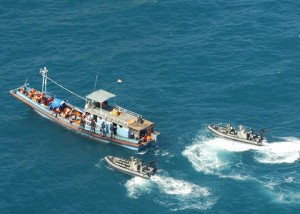Posted 17/09/2010 by Janet Phillips
 Irregular arrivals—what is the solution?
Irregular arrivals—what is the solution?Over the last decade, the immigration debate in Australia has been largely overshadowed by the issue of asylum seekers arriving by boat (irregular arrivals). The issue took centre stage in the 2001 federal election when former Prime Minister John Howard asserted ‘we’ll decide who comes to this country and the circumstances under which they’ll come’. A widespread perception in the community that Australia is being swamped by undocumented asylum seekers continues to strongly influence government policy (see our publications
Asylum seekers and refugees: what are the facts? and
Boat arrivals in Australia since 1976 for more on this). Successive governments have been under constant pressure to adopt effective measures to address border security and combat people smuggling. This continues to be an emotive and divisive election issue, the 2010 federal election being no exception.
The Labor Government consistently maintained that irregular migration is a global challenge linked directly to ‘push factors’ such as conflict and displacement within the region. In contrast, the Coalition attributed the recent increase in irregular boat arrivals to ‘pull factors’ driven predominantly by domestic reform—most notably, Labor’s decision in 2008 to grant refugees permanent residency and discontinue processing of asylum seekers in the small Pacific island State of Nauru. However, prior to the 2010 federal election Labor announced that it too was exploring options for creating a regional processing centre in a foreign country. Both sides of politics agree that people smuggling is an unacceptable organised criminal activity that endangers innocent people’s lives. Both have accordingly committed to increased cooperation with Indonesia and other countries in the region and to creating harsher mandatory penalties for those convicted of people smuggling offences. Some commentators though have criticised the introduction of tougher penalties on the basis that they do not effectively target people smuggling syndicates—rather, they simply punish the often unsuspecting Indonesian fishermen who operate the boats.
Can mandatory detention withstand the test of time?The policy of mandatory detention (that is the legal requirement to detain all non-citizens that do not hold a valid visa) was introduced in the early 1990s. Although it does vary, the majority of the detention population is usually comprised of people who have overstayed their visa or breached their visa conditions. However, the detention of asylum seekers in often remote locations has received greater public attention. In particular, the duration and conditions of their detention have been controversial issues that have plagued successive governments.
Though the policy of mandatory detention has officially remained, it has been somewhat softened in recent years. For instance, in 2005 the former Coalition Government affirmed in legislation the principle that detention of minors would only occur as a measure of last resort. Alternative accommodation was also made available to vulnerable detainees such as families and unaccompanied minors. Upon forming government in 2007, Labor declared that it was committed to treating asylum seekers more humanely. To this end, it removed the statutory obligation to charge detainees for the cost of their detention and announced a series of detention values that the Department of Immigration would follow. These values emphasised a risk-based approach to the management of detainees and thus, in principle, detention centres would only be used as a last resort and for the shortest practicable time. However, some commentators have criticised the Government’s recent decision to temporarily suspend the processing of asylum seekers from Sri Lanka and Afghanistan on the basis that it has led to their indefinite detention. Despite the fact that the Australian Greens and certain former members of the Coalition have strongly advocated for the introduction of a periodic independent review by a tribunal or court of the ongoing need for detention, neither major party has introduced such a mechanism.
A new government will inevitably need to address the enduring and complex problems associated with an expanding detention population. The issue of providing additional and appropriate accommodation to avoid overcrowding and a deterioration of conditions will be a significant challenge.
The bigger picture—how is Australia responding to the global challenge?Increasing numbers of asylum seekers and others in need of humanitarian assistance pose huge challenges for the world’s destination countries. Australia is one of only about 20 nations worldwide responding to these challenges through participation in the United Nations refugee agency’s resettlement program which involves accepting a set number of refugees on an annual basis. However, the UN refugee agency’s resettlement program currently contributes to resettling only a small proportion of the world’s refugees and about 75 to 90 per cent of refugees remain in their region of origin, placing the burden on neighbouring developing countries.
Australia has a highly managed migration system and formally accepts around 13 000 refugees and other humanitarian entrants each year under its Humanitarian Program. The majority of these grants each year go to refugees referred by the UN or to people subject to human rights abuses overseas who have close ties to Australia. Visa grants for refugees within Australia (boat and air arrivals combined) only make up a relatively small proportion of the total number of refugees accepted by Australia each year—usually in the region of 17 to 20 per cent. See our latest publication
Seeking asylum: Australia’s humanitarian response to a global challenge for more on this issue.
(post co-authored with Elibritt Karlsen)
(Image source: WAtoday.com.au, 29 June 2009, http://www.watoday.com.au/national/huge-wave-of-refugees-predicted-20090630-d2w9.html)